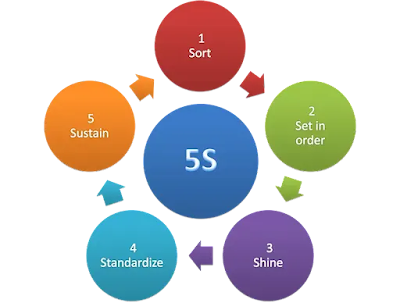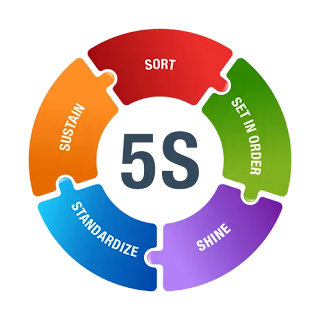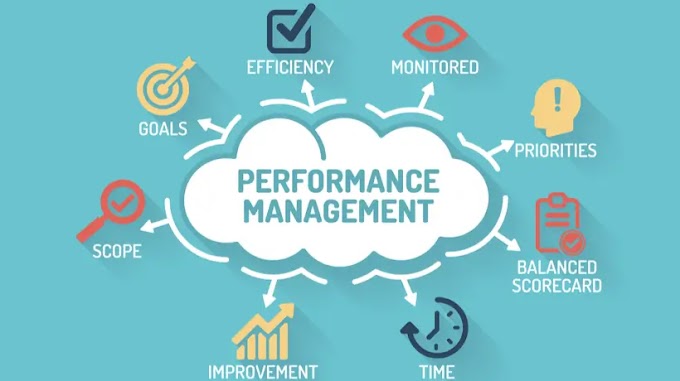In today's fast-paced business environment, it's more important than ever to have an efficient and well-organized workplace. That's where the 5S methodology comes in. 5S is a system of organization and efficiency that originated in Japan and has been widely adopted by businesses around the world. In this article, we'll explore the benefits of implementing a 5S system in your workplace and provide tips on how to successfully do so.
What is 5S?
The 5S methodology is a system of organization and efficiency that originated in Japan. It consists of five principles, each starting with the letter "S" in Japanese:
- Sort - remove unnecessary items from the workplace
- Set in Order - organize the remaining items in a logical and efficient manner
- Shine - clean the workplace to maintain a high level of cleanliness and organization
- Standardize - establish and maintain consistent processes and procedures
- Sustain - ensure that the 5S system is sustained over time
Brief History of 5S
The 5S methodology was developed by Toyota in the 1960s as a way to improve efficiency and eliminate waste in their manufacturing processes. The system was based on the principles of the Lean manufacturing philosophy, which emphasizes the elimination of waste in all aspects of the manufacturing process. Today, 5S has been adopted by a wide range of industries and businesses, both in manufacturing and service sectors.
Purpose of the Article
The purpose of this article is to provide an in-depth understanding of the 5S methodology and its benefits, as well as to provide practical tips on how to successfully implement the system in your workplace. We'll explore how each of the five principles of 5S works together to improve workplace efficiency, and provide real-world examples of 5S implementation and its impact. Additionally, we'll address some common challenges that businesses face when implementing 5S and provide solutions to overcome them.
In the next section, we'll dive into the 5S methodology and how it can benefit your workplace.
The 5S Methodology
The 5S methodology is a powerful tool for improving workplace efficiency, safety, and organization. By following the five principles of Sort, Set in Order, Shine, Standardize, and Sustain, businesses can achieve significant benefits in a variety of areas.
1. Sort
The first step in the 5S methodology is to Sort. This involves removing all unnecessary items from the workplace. This can include tools, equipment, materials, or paperwork that is not essential to the work being done. By removing unnecessary items, businesses can free up valuable space, reduce clutter, and create a safer and more efficient workplace.
Sorting involves identifying and categorizing items into three groups: those that are essential, those that can be stored elsewhere, and those that are no longer needed and should be discarded. Essential items should be kept within easy reach of the worker, while non-essential items should be stored in a designated location, and discarded items should be disposed of properly.
2. Set in Order
Once all unnecessary items have been removed, the next step is to Set in Order. This involves organizing the remaining items in a logical and efficient manner. This can involve creating designated storage areas for specific tools or materials, labeling items clearly, and ensuring that everything has a designated place.
By organizing the workplace in this way, businesses can improve productivity, reduce wasted time spent searching for tools or materials, and reduce the risk of accidents caused by clutter or disorganization.
3. Shine
The third step in the 5S methodology is to Shine. This involves cleaning the workplace thoroughly and regularly. This includes not only regular cleaning but also periodic deep cleaning to ensure that the workplace is free from dust, dirt, and debris.
By maintaining a clean workplace, businesses can improve safety, prevent equipment from breaking down due to dirt or debris, and create a more pleasant and productive working environment. Regular cleaning also helps identify any potential hazards, such as spills or leaks, that could lead to accidents.
4. Standardize
The fourth step in the 5S methodology is to Standardize. This involves establishing and maintaining consistent processes and procedures. This can include creating checklists for cleaning and maintenance, developing standard operating procedures for equipment operation, and establishing guidelines for workplace organization.
By standardizing processes, businesses can improve quality, reduce errors, and ensure that everyone is working towards the same goals. Standardization also helps new employees learn the procedures more quickly and effectively, reducing the time and resources required for training.
5. Sustain
The final step in the 5S methodology is to Sustain. This involves ensuring that the 5S system is sustained over time. This involves ongoing monitoring and maintenance of the 5S system, as well as regular training and education for employees to ensure that they understand the importance of the system and how to use it effectively.
By sustaining the 5S system, businesses can achieve long-term benefits in terms of safety, efficiency, and quality. Regular audits and inspections can help identify any issues or areas for improvement, while ongoing training can help employees stay engaged and motivated to maintain the 5S system.
Visual Representation of the 5S's in Action
To get a better idea of how the 5S methodology works in practice, let's take a look at a visual representation of the 5S's in action:
 |
| 5S methodology |
Why 5S is Important
There are several reasons why 5S is important for businesses of all sizes and industries. Implementing a 5S system can lead to improved safety, increased productivity, better quality, cost reduction, improved morale, and environmental benefits. Let's explore each of these benefits in more detail:
- Improved Safety - A cluttered and disorganized workplace can be hazardous to employees. By implementing the 5S methodology, businesses can identify potential safety hazards and eliminate them. For example, removing unnecessary equipment and materials can help reduce tripping hazards and fire risks. In addition, creating designated storage areas for equipment and materials can help prevent accidents and injuries.
- Increased Productivity - A clean and organized workplace can improve efficiency and productivity. By eliminating unnecessary items and organizing workspaces, employees can spend less time searching for tools and materials, and more time working on productive tasks. In addition, a standardized and consistent workplace can help reduce errors and increase efficiency.
- Better Quality - A well-organized workplace can lead to better quality products and services. By eliminating unnecessary items and standardizing processes, businesses can reduce errors and defects. In addition, a clean and organized workspace can help identify potential quality issues before they become problems.
- Cost Reduction - Implementing the 5S methodology can help businesses reduce costs in several ways. By eliminating unnecessary items, businesses can reduce inventory costs and storage space. In addition, by standardizing processes and reducing errors, businesses can reduce the costs of rework and waste.
- Improved Morale - A clean and organized workplace can help improve employee morale. By providing a safe and pleasant work environment, businesses can increase employee satisfaction and reduce turnover. In addition, involving employees in the 5S implementation process can help foster a sense of ownership and pride in their work.
- Environmental Benefits - Implementing the 5S methodology can help businesses reduce their environmental impact. By eliminating unnecessary items and reducing waste, businesses can reduce their carbon footprint. In addition, a clean and organized workspace can help identify potential environmental hazards and prevent pollution.
Overall, implementing a 5S system can lead to significant benefits for businesses of all sizes and industries. Let's take a look at how businesses have successfully implemented the 5S methodology in the real world.
Real-world Examples of 5S Implementation
Let's take a look at some examples of businesses that have successfully implemented the 5S methodology:
- Toyota - The automotive giant is known for its commitment to the 5S methodology, which has helped the company achieve high levels of efficiency and quality. By implementing the 5S principles, Toyota has been able to reduce waste, improve productivity, and increase customer satisfaction.
- Boeing - The aerospace manufacturer has also implemented the 5S methodology to improve efficiency and safety in its operations. By organizing workspaces and identifying potential safety hazards, Boeing has been able to reduce accidents and injuries and improve productivity.
- Amazon - The e-commerce giant uses the 5S methodology to improve efficiency and organization in its warehouses. By standardizing processes and organizing inventory, Amazon has been able to improve productivity and reduce errors.
By implementing the 5S methodology, businesses can achieve significant benefits in terms of safety, productivity, quality, cost reduction, employee morale, and environmental sustainability. In the next section, we'll explore how businesses can successfully implement a 5S system in their own workplaces.
How to Implement 5S in Your Workplace
Now that we have discussed the benefits of implementing a 5S system in your workplace, it is time to learn how to actually implement it. Here are the steps to successfully implement a 5S system:
- Create a 5S team: The first step is to create a team that will be responsible for implementing the 5S system. This team should consist of individuals from various departments within the organization, including management, production, and maintenance.
- Identify the scope of the project: Determine which areas of the workplace will be included in the 5S implementation. This can range from a single workstation to an entire facility.
- Train employees: Train all employees on the 5S principles and how they will be implemented. This will help to ensure that everyone understands the importance of the 5S system and their role in its success.
- Sort: The first "S" in the 5S system is "Sort." This involves sorting through all items in the workplace and identifying what is necessary and what is not. Items that are not necessary should be removed from the workplace.
- Set in Order: The second "S" in the 5S system is "Set in Order." This involves organizing the necessary items in a logical and efficient manner. This includes labeling items and creating designated storage areas for each item.
- Shine: The third "S" in the 5S system is "Shine." This involves thoroughly cleaning the workplace to ensure that it is safe and hygienic. This should be done on a regular basis to maintain a clean and organized workplace.
- Standardize: The fourth "S" in the 5S system is "Standardize." This involves creating standard procedures and processes for maintaining the 5S system. This helps to ensure that the system is consistently applied and maintained over time.
- Sustain: The final "S" in the 5S system is "Sustain." This involves creating a culture of continuous improvement and maintaining the 5S system over time. This requires ongoing training, monitoring, and feedback to ensure that the system is effective and sustainable.
- Monitor and improve: Monitor the 5S system on an ongoing basis to identify areas for improvement. This includes soliciting feedback from employees and making changes as needed to ensure that the system is meeting its objectives.
- Celebrate success: Celebrate the successes of the 5S system by recognizing the efforts of employees and teams that have contributed to its success. This helps to reinforce the importance of the 5S system and encourage continued commitment to its implementation and maintenance.
Overall, successfully implementing a 5S system requires commitment, teamwork, and ongoing effort. By following these steps and working together, your organization can achieve the many benefits of a 5S system.
Overcoming Common Challenges
While implementing a 5S system in your workplace can bring significant benefits, it is not always an easy process. Here are some common challenges that organizations may face when implementing a 5S system, and how to overcome them:
- Resistance to change: One of the most common challenges is resistance to change. Employees may be hesitant to adopt a new system, especially if it requires them to change their habits and work processes.
- Solution: To overcome this challenge, it is important to involve employees in the 5S implementation process from the beginning. This includes providing training and education on the benefits of the 5S system, as well as soliciting feedback and input from employees throughout the implementation process. This helps to build buy-in and support for the system, and can help to minimize resistance to change.
- Lack of buy-in from employees: Even if employees understand the benefits of a 5S system, they may not be fully committed to its implementation and maintenance.
- Solution: To overcome this challenge, it is important to create a culture of continuous improvement and accountability. This includes setting goals and metrics for the 5S system, regularly communicating progress and results to employees, and recognizing and rewarding employees and teams that contribute to the success of the system. By creating a sense of ownership and responsibility among employees, you can help to ensure that the 5S system is effectively implemented and maintained over time.
- Maintaining a sustainable 5S system: Another challenge is maintaining the 5S system over time. Without ongoing effort and attention, the system can quickly fall apart and lose its effectiveness.
- Solution: To overcome this challenge, it is important to make the 5S system a core part of your organization's culture and processes. This includes integrating the 5S system into employee training and onboarding processes, regularly monitoring and reviewing the system, and providing ongoing training and support to employees. Additionally, it is important to have a plan in place for addressing issues or changes that may arise over time, and to regularly solicit feedback from employees to identify areas for improvement.
By being proactive and addressing these common challenges, your organization can successfully implement and maintain a 5S system, and reap the many benefits that it can bring.
Case Studies
To get a better understanding of how the 5S system can be implemented and its impact on different industries, let's take a look at some real-world examples:
- Toyota: The automotive giant is known for its focus on continuous improvement and the use of the 5S system. By implementing 5S principles in its factories and offices, Toyota has been able to improve efficiency, reduce waste, and increase productivity. Additionally, the 5S system has helped Toyota to create a culture of continuous improvement and employee engagement, which has contributed to the company's overall success.
- Boeing: The aerospace company has implemented the 5S system in its manufacturing facilities, with a focus on reducing waste and improving efficiency. By using the 5S principles of sorting, organizing, cleaning, standardizing, and sustaining, Boeing has been able to optimize its production processes and reduce costs. Additionally, the 5S system has helped to improve safety in Boeing's manufacturing facilities, contributing to a safer and more productive workplace.
- Banner Health: The healthcare provider has implemented the 5S system in its hospitals and clinics, with a focus on improving patient safety and quality of care. By using the 5S principles to organize and standardize processes and equipment, Banner Health has been able to reduce errors and improve patient outcomes. Additionally, the 5S system has helped to improve employee morale and engagement, contributing to a more positive and collaborative workplace culture.
- Starbucks: The coffee retailer has implemented the 5S system in its stores, with a focus on improving customer service and efficiency. By using the 5S principles to organize and standardize store layouts and equipment, Starbucks has been able to improve order accuracy and speed, and provide a more consistent and positive customer experience. Additionally, the 5S system has helped to improve employee satisfaction and engagement, contributing to a more positive and collaborative workplace culture.
These case studies demonstrate the wide-ranging benefits of implementing a 5S system, from improving efficiency and reducing waste to improving safety, quality, and employee morale. By applying the 5S principles to their specific industries and processes, organizations can achieve significant improvements in productivity, quality, and overall performance.
Conclusion
In today's fast-paced and highly competitive business environment, organizations need to continuously look for ways to improve efficiency, reduce costs, and enhance quality. One powerful tool for achieving these goals is the 5S system, which offers a simple but effective framework for organizing and optimizing workspaces, processes, and equipment.
The 5S system is based on five principles: sorting, organizing, cleaning, standardizing, and sustaining. By following these principles, organizations can achieve a range of benefits, including improved safety, increased productivity, better quality, cost reduction, improved morale, and environmental benefits.
Implementing a 5S system requires commitment and effort, but the benefits can be significant. To successfully implement a 5S system, organizations need to involve employees at all levels, provide training and education, and establish a culture of continuous improvement. Overcoming common challenges such as resistance to change and lack of buy-in from employees is also critical for success.
Case studies from industries such as automotive, aerospace, healthcare, and retail demonstrate the real-world impact of implementing a 5S system. By customizing the 5S principles to their specific needs and processes, organizations can achieve significant improvements in efficiency, quality, and overall performance.
In conclusion, the 5S system offers a powerful tool for organizations looking to improve efficiency, reduce costs, and enhance quality. By following the five principles of sorting, organizing, cleaning, standardizing, and sustaining, organizations can achieve a range of benefits that can contribute to their success and competitiveness in today's dynamic business environment.








0 Comments